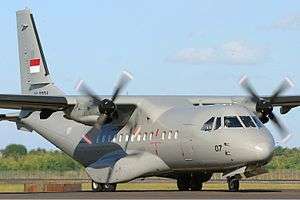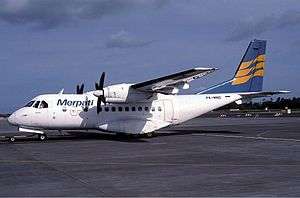Science and technology in Indonesia

Indonesia is not considered as one of the leading countries in science and technology developments. However, there are many examples of notable scientific and technological developments and achievements contributed by Indonesians. Despite being a developing country, Indonesia is one of a handful nations that have developed their own aerospace technology.[1]
Currently, the republic's Ministry of Research and Technology is the official body in charge of science and technology development in the nation. The government institution dedicated to science and research in the country is the Indonesian Institute of Sciences (Indonesian: Lembaga Ilmu Pengetahuan Indonesia or LIPI). It consists of 47 research centers in fields ranging from social to natural sciences.[2] In 2010, the Indonesian government allocated Rp 1.9 trillion (approximately US$205 million) for research and development—less than 1% of the total state expenditure.[3]
History
Living in an agrarian and maritime culture, the people of the Indonesian archipelago have become well known in some traditional technologies, particularly in agriculture and marine. In agriculture for instance, the people in Indonesia and many other Southeast Asian countries, are famous for paddy cultivation and techniques such as terracing. Local systems of complex irrigation and water management have been developed in the archipelagos. An exceptional example is Subak, the irrigation system of Bali.
The Bugis and Makassar people from the island of Sulawesi in eastern Indonesia are also well known for their shipbuilding technology. They are renowned for making a wooden sailing vessel called the pinisi boat.[4]
In architecture, native Indonesians have developed their own vernacular architecture. Some examples of architecturally significant Indonesian buildings are Rumah Gadang of Minangkabau, Tongkonan of Toraja, and omo sebua of Nias. The omo sebua is noted for its sturdy yet flexible design which allows it to resist earthquake.

By the 8th century, the Javanese kingdom of Medang Mataram developed an advanced stone mason architectural technology in candi (temple) building. This includes the magnificent Borobudur, Prambanan and many other temples. Architectural techniques that have been developed include knobs, indentations and dovetails used to form joints between stones and bind them without mortar. Other significant architectural advancements include: the roof, niches, and arched gateways constructed in the corbelling method.
Indonesians have also made various advances in food technology, due in part to the tropical climate in Indonesia teeming with various microbes. Indonesians have developed traditional knowledge in fermentation techniques, which resulted in the development of fermented foods such as tempeh, oncom, tapai, and also beverages like brem and tuak. Tempeh is made through natural culturing and a controlled fermentation process, which employs the fungi Rhizopus oligosporus or Rhizopus oryzae,[5] The fungi binds soybeans into a cake form. It has higher content of protein, dietary fiber, and vitamins.[6]
Construction technology
There are some notable technological developments made by natives in modern Indonesia (post independence). In the 1980s, Tjokorda Raka Sukawati, an Indonesian engineer, invented a road construction technique called Sosrobahu. It was popularized afterwards and has since been widely used by many countries. The Sosrobahu technique allows long stretches of flyovers to be constructed above existing main roads with minimum disruptions to the heavy traffic. It involves the construction of horizontal supports for the highway beside the existing road, which is then lifted and turned at a 90 degree angle before being placed on the top of the vertical supports. This forms the flyover pylons. The technology was exported to the Philippines, Malaysia, Thailand and Singapore. In 1995, a patent was granted to Indonesia.[7]
The Cakar ayam construction, or literally means "chicken claw construction" is a technical engineering to create a more stable foundation by employing concrete plate supported by pipes planted deep into the ground acted as "claws", invented by Prof. Dr. Ir. Sedijatmo in 1961. The technique is applied on structures, roads and runways. The technical principle consist of a concrete plate foundation is supported and secured to the ground by pipes as "claws", which allowed a more stable construction, enable to build structure on soft wet ground such as on swamps. The technique allowed the structure to be more rigid, stable and more durable against uneven weight distribution or uneven land declining.[8]
Aerospace and transportation
Indonesia has a long history in developing military and small commuter aircraft. In fact, it is the only country in Southeast Asia to produce and develop its own aircraft. Its state-owned aircraft company (founded in 1976), Indonesian Aerospace (Indonesian: PT. Dirgantara Indonesia) has also produced aircraft components for Boeing and Airbus. Indonesian Aerospace, together with EADS CASA of Spain, also developed the CN-235 aircraft, which has been exported to many countries. B. J. Habibie, a former Indonesian president, played an important role in this achievement. While active as a professor in Germany, Habibie conducted many research assignments, producing theories on thermodynamics, construction, and aerodynamics, known as the Habibie Factor, Habibie Theorem, and Habibie Method respectively.[9] Indonesia also hopes to manufacture the South Korean KAI KF-X fighter.[10] The latest development is N-219, a twin-engine 19-seater commuter airplane.[1]
Wiweko Soepono, a former Garuda Indonesia director, is also known as inventor of the modern two-man cockpit design (Forward Facing Crew Cockpit/FFCC) for Garuda Indonesia Airbus A300 aircraft.[11]
Furthermore, Indonesia has a well-established railway industry with its state-owned train manufacturing company, the Indonesian Railway Industry (Indonesian: PT. Industri Kereta Api), located in Madiun, East Java. Since 1982, the company has been producing passenger train wagons, freight wagons and other railway technologies which it has exported to many countries such as Malaysia and Bangladesh.[12]
Information and communication technology
Indonesia was one of few countries during the 1970s to own their own communication satellite. Since 1976, a series of satellites named Palapa were built and launched in the United States for Indonesia's state-owned telecommunication company, Indosat.
In Internet technology, an Indonesian information technology scientist, Onno W. Purbo developed RT/RW-net, a community-based internet infrastructure which provides affordable Internet access to people in rural areas.[13]
Robotics
Indonesian students have a good record of winning many international competitions in science and technology. In 2009, the robotics team from Indonesian Computer University won the gold medal in the “open fire-fighting autonomous robot” category at the Robogames in San Francisco, United States[14]. In 2010, they successfully defended their title. Two years earlier, another robotics team from the Tenth of November Institute of Technology won third place in Robocon 2008, a robotics contest hosted by the Asia-Pacific Broadcast Union (ABU) in Pune, India.[15]
Notable people
- B. J. Habibie, German-trained professor in aerospace engineering. Produced theories known as the Habibie Theorem, Habibie Factor, and Habibie Method. Later he became the president of Indonesia.
- Bambang Hidayat, former Vice-President of the International Astronomical Union.
- Onno W. Purbo, Internet and information technology expert. Well known for his design on RT/RW-net, a community-based Internet solution for poor people.
- Yohanes Surya, physics scientist and professor.
- Moedomo Soedigdomarto, one of the first Indonesians to obtain a Ph.D. in mathematics.
See also
External links
References
- 1 2 Marguerite Afra Sapiie. "N-219: Propelling Indonesia's aerospace industry". The Jakarta Post.
- ↑ "About LIPI". Indonesian Institute of Science. Archived from the original on 27 May 2013.
- ↑ Indonesia to increase R&D budget
- ↑ The Indonesian Phinisi
- ↑ "What is tempeh starter?". Tempeh.info.
- ↑ Bennett, Beverly Lynn; Sammartano, Ray (2008). The Complete Idiot's Guide to Vegan Cooking. Penguin. p. 17. ISBN 9781592577705. Retrieved 6 May 2011.
- ↑ Sosrobahu Bertumpu di Atas Piring
- ↑ "Pondasi Cakar Ayam". ilmutekniksipil.com (in Indonesian). 12 October 2012.
- ↑ Habibie receives honorary doctorate Archived 5 March 2016 at the Wayback Machine.
- ↑ "Indonesia Angling to Help Build S. Korean Jet Fighter", The Jakarta Globe, Jakarta, 16 July 2010, archived from the original on 18 September 2012, retrieved 18 November 2010
|first1=missing|last1=in Authors list (help) - ↑ Wiweko Perancang Pesawat Indonesia Pertama
- ↑ PT. INKA's Products
- ↑ Onno W. Purbo: Opening windows for knowledge
- ↑ A Man and His Robot Make the Most of a Golden Opportunity
- ↑ THE ROBOT TEAM OF ITS WON THE THIRD PLACE IN AN ASIA PACIFIC COMPETITION

